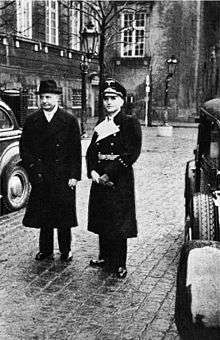Deportation of the Danish police
.jpg)
During World War II, the Danish government chose to cooperate with the Nazi occupation force. Even though this applied to the Danish police as well, many were reluctant to cooperate. As a result, a large number of members of the Danish police force were deported to Nazi concentration camps in Germany. The Gestapo established the collaborationist HIPO Corps to replace them.
April 1940–September 1944
Nazi Germany occupied Denmark on 9 April 1940, and the Danish cabinet decided on a policy of collaboration. This applied to all civil servants, including the entire Danish police force, which began cooperation with its German counterparts.[1]

On 12 May 1944, Dr. Werner Best demanded that the Danish police should protect 57 specific enterprises against sabotage from the Danish resistance movement, which was growing in strength. Should the Danish civil service not accept this, the Danish police force would be reduced from 10,000 to 3,000 men. The head of the Danish administration, Nils Svenningsen, was inclined to accept this demand, but the organizations of the Danish police were opposed to the idea. The German request was ultimately turned down, and this was reported to Dr. Best on 6 June 1944. This reduced the Gestapo's already limited trust in the Danish police even further.
Arrest and deportation
The German army began arresting members of the Danish police in Denmark's main cities on 19 September 1944. The force numbered 10,000 men in that year.[2] 1,960 personnel were arrested and later deported to the Neuengamme concentration camp.[3] Policemen deported to Buchenwald were in two groups, the first group was sent on 29 September, the second was transferred on 5 October, 1944. On 16 December, following pressure from the Danish administration, 1604 men were transferred from Buchenwald to Mühlberg (Stammlager or Stalag IV-B), a camp for prisoners of war (POW)s. That meant an improvement in the situation for the Danish policemen; POWs had some kind of protection due to international conventions; inmates in concentration camps did not.[4][5]
Subsequently the policemen were scattered somewhat on various work details.
Negotiations
The Danish ministry of foreign affairs headed by Nils Svenningsen negotiated with the German authorities in Denmark over the release of Danish concentration camp inmates.[6] From late September 1944, transport with Red Cross packs was organized. An agreement was reached on 8 December 1944, for the release (and transport back to Denmark) of 200 sick policemen.
Simultaneously with the Danish negotiations, the Swedish count Folke Bernadotte intended to get all Scandinavian concentration camp prisoners to Sweden. The efforts to get prisoners from Scandinavia out of the German camps continued in the following months. In March and April 1945, 10,000 Danish and Norwegian captives were brought home from Germany in White Buses. The majority of the deported policemen travelled with these vehicles. Some of the returning captives arrived at Frøslev Prison Camp just north of the border between Germany and Denmark.
Number of deaths
The number of Danish policemen who died during their incarceration in the German camps varies between 81 and 90, depending on the source.[7] Several died afterwards due to camp-related illnesses. This group is a little more difficult to delimit. According to a calculation in 1968, 131 policemen died.[8]
The mortality rate among the Danish policemen was reduced after they left Buchenwald and were transferred to Mühlberg in December 1944. 62 men died in Buchenwald.
References
- ↑ "Gads leksikon om dansk besættelsestid 1940-1945." Published 2002. Page 367
- ↑ "19. September" by Carl Aage Redlich, published 1945, page 11.
- ↑ The arrest and deportation of these men is described on page 122 of "Helvede har mange navne." by Jørgen Barfod and "Fange—dog fri / en dansk politimands oplevelser i tysk fangenskab 19. September 1944 til 4. maj 1945." by Aage Nielsen. Published in 1970. From page 94 and the following pages.
- ↑ In 1933 Hitler issued a decree which warranted imprisonment of people indefinitely according to page 277 in "Gads leksikon om dansk besættelsestid 1940–1945." Published 2002.
- ↑ Page 280 in "Gads leksikon om dansk besættelsestid 1940-1945." Published 2002.
- ↑ Page 378 in "Gads leksikon om dansk besættelsestid 1940-1945." Published 2002.
- ↑ According to page 79 in Walter Bartels book "Buchenwald : Mahnung und Verpflichtung : Dokumente und Berichte", published in 1960, 90 Danish policemen died in the camps.
- ↑ The source from 1968 is quoted page 280 in "Fange—dog fri / en dansk politimands oplevelser i tysk fangenskab 19. September 1944 til 4. maj 1945." written by Aage Nielsen. Published 1970.